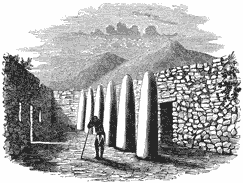One of the World's Leading
Sources of Information On Literature, the Arts, and a Wide Range of
Subjects
Mitla
(This is taken from John D. Baldwin's Ancient America, originally published in 1871.)

The ruins called Mitla are in the Mexican State of Oaxaca, about twelve leagues east from the city of Oxaca. They are situated in the upper part of a great valley, and surrounded by a waste, uncultivated region. At the time of the Spanish Conquest they were old and much worn by time and the elements, but a very large area was then covered by remains of ancient buildings. At present only six decaying edifices and three ruined pyramids, which were very finely terraced, remain for examination, the other structures being now reduced to the last stage of decay.
These important ruins were not described by Stephens and Catherwood. Captain Dupaix’s work gives some account of them, and Desiré Charnay, who saw them since 1860, brought away photographs of some of the monuments. Four of the standing edifices are described by Dupaix as “palaces,” and these, he says, “were erected with lavish magnificence; . . . they combine the solidity of the works of Egypt with the elegance of those of Greece.” And he adds, “But what is most remarkable, interesting, and striking in these monuments, and which alone would be sufficient to give them the first rank among all known orders of architecture, is the execution of their mosaic relievos, very different from plain mosaic, and consequently requiring more ingenious combination and greater art and labor. They are inlaid on the surface of the wall, and their duration is owing to the method of fixing the prepared stones into the stone surface, which made their union with it perfect.”
The general character of the architecture and masonry is much like that seen in the structures at Palenque, but the finish of the workmanship appears to have been more artistic and admirable. These ruins are remarkable among those of the country where they are found. All who have seen them speak much as Dupaix speaks of the perfection of the masonry, the admirable design and finish of the work, and the beauty of the decorations. Their beauty, says M. Charnay, can be matched only by the monuments of Greece and Rome in their best days. One fact presented by some of the edifices at Mitla has a certain degree of historical significance. There appears to be evidence that they were occupied at some period by people less advanced in civilization than their builders. M. Charnay, describing one of them, points out this fact. He says of the structure:
“It is a bewildering maze of courts and buildings, with facings ornamented with mosaics in relief of the purest design; but under the projections are found traces of paintings wholly primitive in style, in which the right line is not even respected. These are rude figures of idols, and meandering lines that have no significance. Similar paintings appear, with the same imperfection, on every great edifice, in places which have allowed them shelter against the ravages of time. These rude designs, associated with palaces so correct in architecture, and so ornamented with panels of mosaic of such marvelous workmanship, put strange thoughts in the mind. To find the explanation of this phenomenon, must we not suppose these palaces were occupied by a race less advanced in civilization than their first builders?”
Two miles or more away from the great edifices here mentioned, toward the west, is the “Castle of Mitla.” It was built on the summit of an isolated and precipitous hill of rock, which is accessible only on the east side. The whole leveled summit of this hill is inclosed by a solid wall of hewn stone twenty-one feet thick and eighteen feet high. This wall has salient and retiring angles, with curtains interposed. On the east side it is flanked by double walls. Within the inclosure are the remains of several small buildings. The field of these ruins was very large three hundred years ago. At that time it may have included this castle.
Home | Book Collecting | Folklore / Myth | Philately | Playing Cards | Literature | Contents
